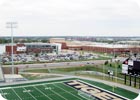Reading, Writing and IP Video

Bentonville High School committed to moving from analog to newer IP video technologies to improve campus security.
In Arkansas, Bentonville High School, as part of a campus-wide initiative to transfer its surveillance technology from analog to newer IP video technologies, moved to network video surveillance solutions for campus security.
The initial deployment consists of 190 Wren network video cameras throughout the second high school building, covering key areas such as building entrances and exits, hallways and gymnasiums. The software, a Windows-based application, will manage the school’s video by allowing administrators to capture and review video from all cameras and easily access live and archived video from a PC. The software will allow the operation to capitalize on the benefits of IP video, accessing video remotely, distributing and managing video access among multiple users and accessing live views of cameras within the building using intuitive building photos and blueprints embedded with camera icons.
NEW TECH USES
Bentonville has a student enrollment of 2,833 students and prides itself on offering students a state-of-the-art facility, which is currently 505,000 square feet. An early adopter of new technologies, from IP phone systems to 24 “21st Century Classrooms,” which include multimedia capabilities, interactive white boards and personal responders, it recognized the need to evolve its video surveillance system from analog to networked IP technologies.“At Bentonville Schools, we have invested heavily in our network infrastructure. We first installed IP phones on the campus in 2000 and have remained early adopters of new technologies ever since,” said Keith Line, district network administrator, Bentonville Schools. “However, we realized that our analog cameras were antiquated and the service agreements were not affordable. Putting video cameras on the IT network will enable us to leverage these existing technology investments while significantly improving our campus security.”
Network video will also allow the organization to connect with the local police department in a way that could potentially save lives. Local law enforcement personnel will be able to view video so that, in case of an emergency, police officers can access video camera images from the station via the Internet to see live video. If an incident occurs, access to video enables police to prepare ahead of time and share information with on-site officers based on what is happening inside the campus. The police department is also well-positioned to more effectively deploy resources and more accurately respond in real-time to the incident.
By switching from analog to network video, the district will experience several key advantages other schools making the same transition could also benefit from, including increased control, reliability and scalability of the surveillance systems; decreased installation and maintenance costs; the ability to share video among school and law enforcement personnel; and ultimately, the capability to respond more quickly and effectively to security threats on the campus.
Line, the security team and administrators there foresee many other areas where video will be of use and are trying to raise money to install network video in all 14 schools in the district. “In a school of so many students, there is always something going on,” said Line.
Looking for a reprint of this article?
From high-res PDFs to custom plaques, order your copy today!





